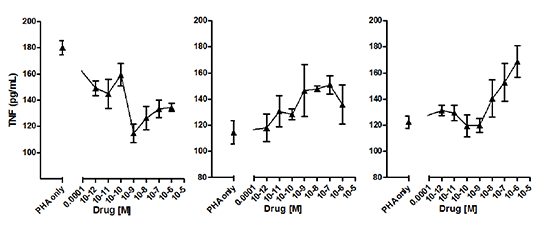280P Queen Elizabeth II Conference Centre London
Pharmacology 2014 |
Conversion of human T-cell TNFα synthesis inhibition by oligo- sulphated disaccharides to stimulation on increased incubation times.
Hilda Bellony1, Daniel Tilley1, Rezina Sharmin1, Michael Burnet2, Michael Seed1. 1University of East London, London, UK, 2Synovo GmbH, Tubingen, Germany
Sulphated disaccharides (SDS) have been postulated to play a role in the regulation of inflammation through formation from T-cell heparanase at inflammatory sites (1)through unknown molecular mechanisms. Oligosulphated SDS sucrose octasulphate (SOS) and the novel SDS diglucopyranosyl-amine octasulphate (DiGaS) inhibit collagen, antigen induced arthritis (2) and SDS adjuvant arthritis (3). We have shown that oligo-sulphated disaccharides inhibit phytohæmagglutinin (PHA) induced TNFα synthesis by Jurkat cells (4), replicating the results of others for primary T-cells (1). This function is reported to depend on the time of administration of the drug with respect to the administration of the stimulus (1), and exhibit bell shaped concentration effect curves. We have investigated the time dependency of incubation of Jurkat cells with SDS in relation to the addition of the T-cell receptor activator PHA.
Jurkat cells cultured in FCS and glutamine RPMI-1640 were seeded (96 well plates, 105/well). TNFα synthesis was induced with PHA (1μg/mL) incubated for up to 72 hours. Cells were treated pre- or post- PHA with SOS (TC, Canada), HDSIII-H (Sigma), or diGAS (Synovo GmbH). Cell viability was confirmed by trypan blue exclusion. TNFα assayed by ELISA (eBioscience). Stats: ANOVA, post hoc Dunnett\\\'s test.
PHA induced Jurkat TNFα synthesis. Pre-incubation of cells for 24, 18, or 2 hours with SDS drugs at 0.01nM to 1μM prior to the addition of PHA inhibited TNFα synthesis by Jurkat cells from (p<0.001 all points) with no difference with preincubation times ranging from 2 to 48 hours. The addition of SOS and HDSIIIS drugs one hour after PHA also reduced synthesis, DiGaS in a bell shaped fashion, when incubated to 18 hours (Fig. 1). However, increasing the incubation period to 24 hours, the synthesis inhibition ceased, and at 48 hours drugs induced TNFα synthesis in a concentration dependent fashion.

Figure 1. The action of SOS (0.01nM-1 μ M) on Jurkat cell TNFα synthesis when administered 1 hr after PHA and incubated (from left to right) for 18, 24 and 48 hours. Mean +/- s.e.m. n=8.Similar results were seen with diGaS. HDSIIIH inhibited TNFα synthesis at 18 hours, reversed by 24 hours, but did not stimulate synthesis at 48 hours incubation. SDS inhibit TCR mediated TNFα synthesis by T-cells. The fructofuranosyl carbohydrate of SOS is interchangeable with the glucopyranosyl of DiGaS, and the O linkage of SOS can be replaced by the N linkage of DiGaS. Substitution with acetyl at the N link does not abrogate activity. Reduction of sulphates to from eight as in SOS and DiGaS to two as in HDSIIIH retains the early inhibitory responses, but the TNFα stimulatory activity appears to be abolished by reducing the number of sulphates to two in HDSIIIH indicating selectivity of action and possible differences in molecular interactions. Sulphation is important in that removal abrogates inhibitory activity (1).
(1) Lider O et al., 1995 P.N.A.S. 92: 5037-5041;
(2) Jones MR et al, Inflammation Res 57(S2):S105, 2008;
(3) Cahalon et al., 1997 Int. Immunol. 9: 1517-1522;
(4) Isaacs et al., pA2online (2013) 1(3): 204P.
|